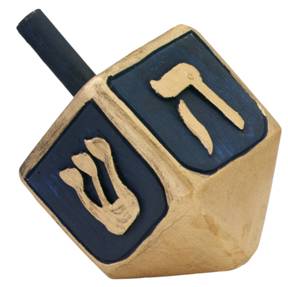Hanukkah, a Jewish holiday started last night, December 20th. Upward Bound - Avila University encourages our students and their families to get familiar with holiday traditions across the globe. Below is a brief explanation of Hanukkah and what it means to Jewish faith.
Hanukkah (Hebrew: חֲנֻכָּה, Tiberian: Ḥănukkāh, usually spelled חנוכה pronounced [χanuˈka] in Modern Hebrew, also romanized as Chanukah, Chanukkah, or Chanuka), also known as the Festival of Lights, is an eight-day Jewish holiday commemorating the rededication of the Holy Temple (the Second Temple) in Jerusalem at the time of the Maccabean Revolt of the 2nd century BCE. Hanukkah is observed for eight nights and days, starting on the 25th day of Kislev according to the Hebrew calendar, which may occur at any time from late November to late December in the Gregorian calendar.
A dreidel is played with during Hanukkah.
The festival is observed by the kindling of the lights of a unique candelabrum, the nine-branched Menorah or Hanukiah, one additional light on each night of the holiday, progressing to eight on the final night. The typical Menorah consists of eight branches with an additional raised branch. The extra light is called a shamash (Hebrew: שמש, "attendant" or "sexton") and is given a distinct location, usually above or below the rest. The purpose of the shamash is to have a light available for use, as using the Hanukkah lights themselves is forbidden.
Hanukkah is celebrated by a series of rituals that are performed every day throughout the 8-day holiday, some are family-based and others communal. There are special additions to the daily prayer service, and a section is added to the blessing after meals. Hanukkah is not a "Sabbath-like" holiday, and there is no obligation to refrain from activities that are forbidden on the Sabbath, as specified in the Shulkhan Arukh. Adherents go to work as usual, but may leave early in order to be home to kindle the lights at nightfall. There is no religious reason for schools to be closed, although, in Israel, schools close from the second day for the whole week of Hanukkah. Many families exchange gifts each night, and fried foods are eaten.
The single light each night for eight nights. As a universally practiced "beautification" of the mitzvah, the number of lights lit is increased by one each night.An extra light called a shamash, meaning "attendant" or "sexton," is also lit each night, and is given a distinct location, usually higher, lower, or to the side of the others. The purpose of the extra light is to adhere to the prohibition, specified in the Talmud (Tracate Shabbat 21b–23a), against using the Hanukkah lights for anything other than publicizing and meditating on the Hanukkah story. This differs from Sabbath candles which are meant to be used for illumination. Hence, if one were to need extra illumination on Hanukkah, the shamashcandle would be available and one would avoid using the prohibited lights. Some light the shamash candle first and then use it to light the others. So all together, including the shamash, two lights are lit on the first night, three on the second and so on, ending with nine on the last night, for a total of 44 (36, excluding the shamash).
The lights can be candles or oil lamps. Electric lights are sometimes used and are acceptable in places where open flame is not permitted, such as a hospital room. Most Jewish homes have a special candelabrum or oil lamp holder for Hanukkah, which holds eight lights plus the additional shamash light.
The reason for the Hanukkah lights is not for the "lighting of the house within", but rather for the "illumination of the house without," so that passersby should see it and be reminded of the holiday's miracle. Accordingly, lamps are set up at a prominent window or near the door leading to the street. It is customary amongst some Ashkenazim to have a separate menorah for each family member (customs vary), whereas most Sephardim light one for the whole household. Only when there was danger of antisemitic persecution were lamps supposed to be hidden from public view, as was the case in Persia under the rule of the Zoroastrians, or in parts of Europe before and during World War II. However, most Hasidic groups light lamps near an inside doorway, not necessarily in public view. According to this tradition, the lamps are placed on the opposite side from the mezuzah, so that when one passes through the door he is surrounded by the holiness of mitzvoth.
Generally women are exempt in Jewish law from time-bound positive commandments, however the Talmud requires that women engage in the mitzvah of lighting Hanukkah candles “for they too were involved in the miracle.”



No comments:
Post a Comment